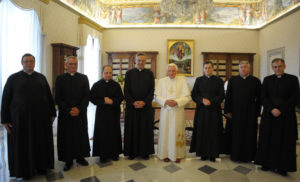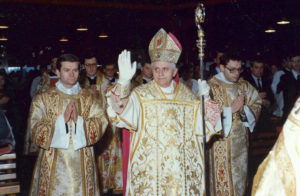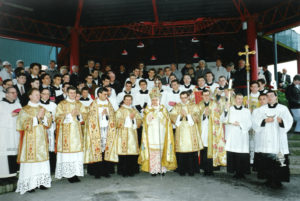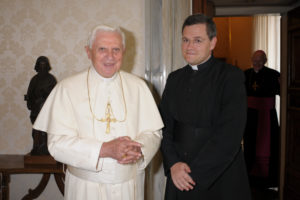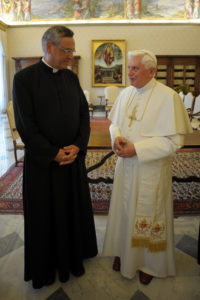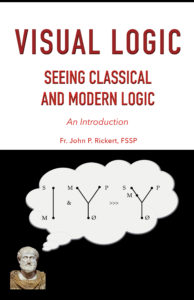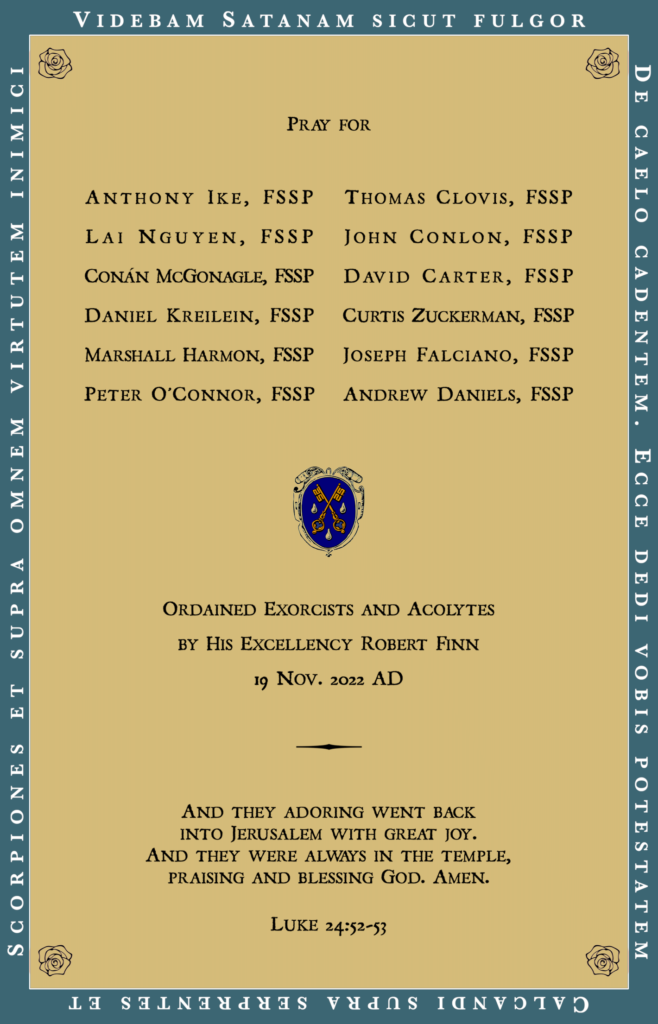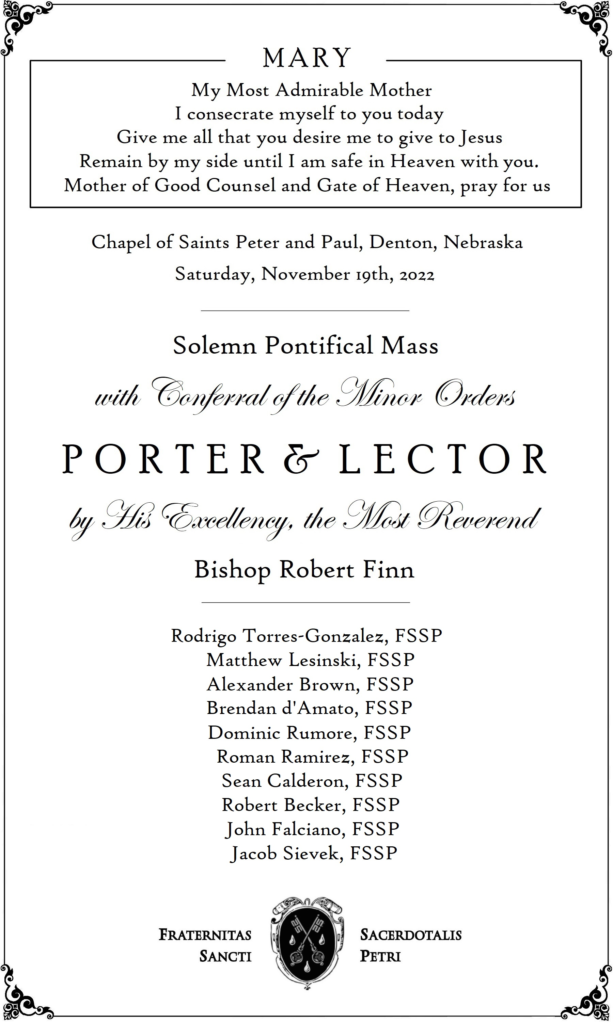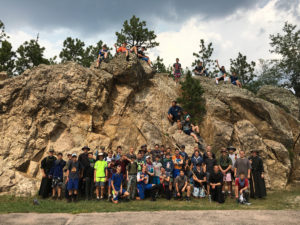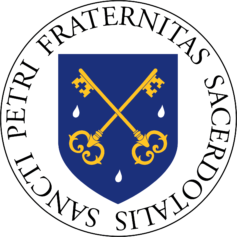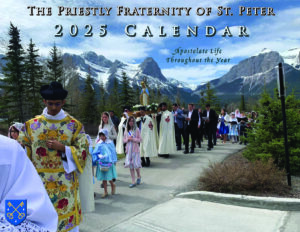Death of Pope Emeritus Benedict XVI
Fribourg, December 31, 2022
It is with sorrow that the Priestly Fraternity of St. Peter learned today, December 31, 2022, of the death of Pope Emeritus Benedict XVI, who was on several occasions a providential support for our community. As Cardinal Prefect of the Congregation for the Doctrine of the Faith, he was instrumental in the founding of the Fraternity and even visited its seminary in Wigratzbad for Holy Week in 1990. After his election to the chair of Peter, the personal contact continued, especially with the private audience he granted to his founders and the Superior General on July 6, 2009: it was for us the occasion to thank him for the Motu Proprio Summorum Pontificum. A few months ago, from his place of retirement at the Mater Ecclesiæ monastery in the Vatican, he sent a private letter of encouragement to the Superior of the Fraternity of Saint Peter following the Motu Proprio Traditiones Custodes. The priests of the Fraternity, together with the faithful who are close to it, will be ardently praying for the repose of his soul. Requiem Masses with the absolution will be celebrated in the apostolates entrusted to the Fraternity in order to “pray to God that through the Sacrifice offered for the soul of his servant, the Sovereign Pontiff Benedict XVI, and after having raised him in this world to the papal office, he may be admitted into the celestial kingdom in the company of all the saints.” (secret of the Requiem Mass for a Sovereign Pontiff)
Source: www.fssp.org
December 31, 2022

Benjaminite Comites
by Fr. William Rock, FSSP
The three Feasts following Christmas – St. Stephen, St. John the Apostle, and the Holy Innocents – are known as the Comites Christi, that is, the “Companions of Christ,” as they are the first Saints on the liturgical calendar to attend, as it were, to the newborn Christ Child. These three feasts are also seen as representing the three forms of martyrdom. St. Stephen, the Protomartyr, was a martyr in desire and in act, St. John was a martyr in desire but not in act (he was miraculously saved when cast into boiling oil, which miracle resulted in his exile to the Island of Patmos),1 and the Holy Innocents were martyrs in act but not in desire. The liturgical colors traditionally assigned to each day reinforced this distinction – St. Stephen’s feast with red, St. John’s with white, and the Holy Innocents’ with violet.2 The importance of these feasts was also manifested in that each, in addition to Christmas, was celebrated with an octave. But there is another discernible theme running through these feasts and that is the Hebrew tribe of Benjamin.
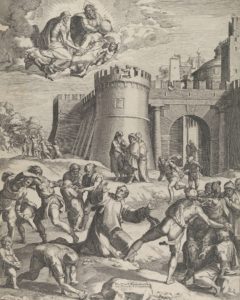
Depending on where the stoning of St. Stephen, the first martyr after the Resurrection, occurred, he may have been martyred in the territory of the tribe of Benjamin as the city of Jerusalem is divided between the territories of the tribes the Judah and Benjamin (Act 7:58). More clearly, the conversion of the Apostle Paul, of the tribe of Benjamin (Phil 3:5), is attributed, at least in part, to the prayers offered up by Stephen for those persecuting him (Act 7:59). For Paul was present and held the cloaks of those conducting the execution, thus consenting to it.
St. John can also be seen as having a connection to the tribe of Benjamin. But in order to understand this, it is important to recognize, as Dr. Brant Pitre explains in his Jesus and the Jewish Roots of Mary – Unveiling the Mother of the Messiah, that the person of Joseph, son of Jacob/Israel and Rachel, is a type or foreshadowing of Our Lord and Rachel of Our Lady. As Dr. Pitre spends an entire chapter explaining these connections, a full analysis cannot be presented here, but it is important to note that Joseph and Benjamin were brothers, the sons of Jacob/Israel and Rachel and that Rachel was the most-favored and most-beloved wife of Jacob. This is why Joseph was favored by Jacob above the rest of his brothers. He was the firstborn of Rachel, the most-beloved wife. Joseph, for his part, showed special love and affection for his only full-brother, Benjamin, the younger son of Rachel.
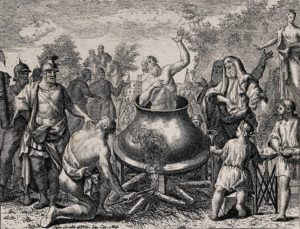
The Benjaminite connection with St. John the Apostle comes from his crucifixion account where Our Lord, the new Joseph, gives St. John to Our Lady, the new Rachel, as a second son. The second son of Rachel, as was stated, was Benjamin. Following the pattern, this would make St. John a new Benjamin. Dr. Pitre argues the St. John was aware of this as he never names himself in his Gospel, rather he calls himself the “disciple whom Jesus loved.” For in the Book of Deuteronomy (33:12), it is written that Benjamin is “beloved of the Lord.” Dr. Pitre’s position can be summarized as follows:
In order words, just as Benjamin was specially loved by Joseph because they were both sons of Rachel, so John is especially “loved” by Jesus because they have the same mother. Just as Joseph was the firstborn son of Rachel in the Old Testament, so Jesus is the firstborn son of Mary in the New Testament. And just as Benjamin was the “son” of Rachel’s “sorrow” [Rachel originally named her second son “Benoni, that is, the son of my sorrow: but his father called him Benjamin, that is, the son of my right hand” (Gen 35:18)], because she had to die to give birth to him, so John becomes the “son” of Mary’s sorrow, because Mary becomes his mother only through the anguish and “sorrow” that she experiences at the foot of the cross.3
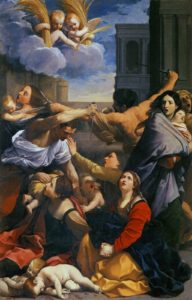
Finally, there are the Holy Innocents. The connection between the Holy Innocents and Benjamin is made explicitly by Scripture itself, for in their regard St. Matthew in his Gospel draws from this prophecy of Jeremias: “then was fulfilled that which was spoken by Jeremias the prophet, saying: A voice in Rama was heard, lamentation and great mourning; Rachel bewailing her children, and would not be comforted, because they are not” (Mat 2:17-18). This prophecy is applicable because Rachel “was buried in the highway that leadeth to Ephrata, this is Bethlehem” (35:19) and it was not just the babies in Bethlehem who were martyred, but also those “in all the borders thereof” (Mat 2:16), and Bethlehem, although in the territory of the tribe of Judah, is close by the territory of the tribe of Benjamin, whose mother was Rachel. As such, the horror ordered by Herod would have spilled over from the territory of the tribe of Judah into that of Benjamin also. The Roman Church recognizes the connection of the Holy Innocents with tribe of Benjamin by appointing the Church of St. Paul Outside the Walls as the Station Church for this feast. As stated above, St. Paul was of the tribe of Benjamin.
The question can now be asked, what is the purpose of the theme of Benjamin present in these feasts? In the first place, Benjamin, by association, brings to mind Joseph and Rachel. As such, these feasts shed light on the two major feasts between which the Comites fall. On Christmas Day, the beloved Son of the Father was born from the most-beloved Spouse of the Holy Ghost, the Blessed Virgin Mary, the new Rachel. This Son will be condemned by those to whom He desires to be close, as Joseph was, but, in the end, God, as He did with Joseph, will use the inflicted evil to save those who share in the guilt of the condemnation. Turning to the Octave Day of Christmas, it must be noted that the prophecy of Jeremias quoted in connection with the Holy Innocents was made centuries after Rachel’s death and gives witness to the belief that Rachel, although dead, was still aware of what was occurring in the land of the living and would intercede on behalf of the living. In fact, it was held that her intercession was greater than that of Moses and Abraham.4 As the new Rachel, it would be expected that Mary would also act as a maternal intercessor in heaven for those still on the earth. And this is what is found in the Collect and Postcommunion in the Mass for the Octave Day of Christmas. In these prayers, the Church invokes Mary’s intercession.
Secondly, it must be remembered that Benjamin means “son of my right hand.” In Sacred Scripture, the “right hand” is often a sign of strength or power (e.g., Ps 117:16). So, Benjamin could be understood to mean “son of my power.” Martyrdom, for its part, requires a special grace from God to undergo not only death in witnesses of the Faith, but also to endure without apostatizing the horrible tortures and pains which, in many cases, accompany the deathblow.5 In honoring the martyrs, then, Christians not only celebrated the witness provided by individual martyrs but also the victory won by Christ through them. As a special grace, a special strength, from God is needed to undergo martyrdom for the faith, each martyr can be seen as a “son of God’s power,” every martyr can be seen as a Benjamin of God. This may explain why the theme of Benjamin is present in these three feasts which represent the three types of martyrdoms.
William Rock, FSSP was ordained in the fall of 2019 and is currently assigned to Regina Caeli Parish in Houston, TX.
- Prior to the liturgical reforms of 1960, the Feast of St. John before the Latin Gate, which commemorated this attempted martyrdom, was observed on the universal Roman liturgical calendar as a major double on May 6th. While the feast is no longer observed, the Mass of this feast may be said on this day.
- For more information about these feasts see Guéranger, Prosper. The Liturgical Year, 2 (Christmas). Trans. Shepherd, Laurence. (Fitzwilliam: Loreto Publications, 2000).
- Pitre, Brant. Jesus and the Jewish Roots of Mary – Unveiling the Mother of the Messiah. (New York: Image Press, 2018), 177.
- Pitre, 168.
- For example, see Garrigou-Lagrange, Réginald. The Priest in Union with Christ. Part 3, Section 2, Chapter 3
December 26, 2022

FSSP Advent 2022 Photopost
As we wind down Advent this week and prepare ourselves for the joyous celebration of Christ’s birth, we share some Advent photos from various Fraternity apostolates in North America.
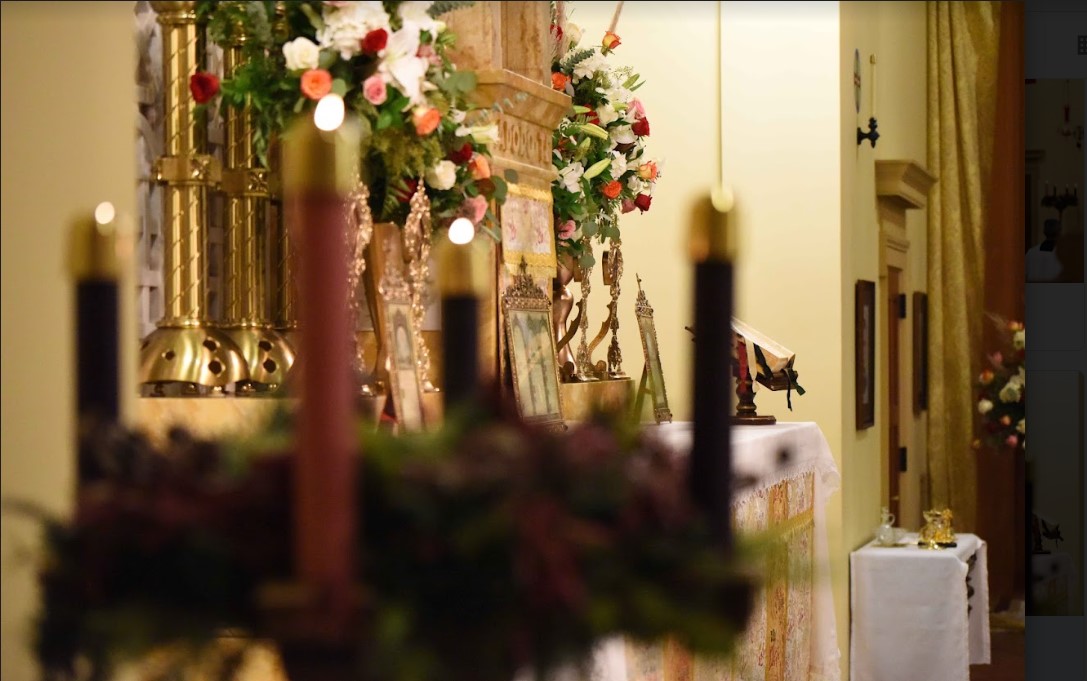
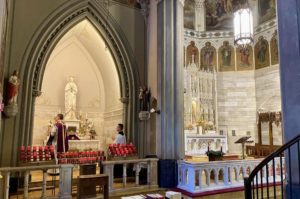
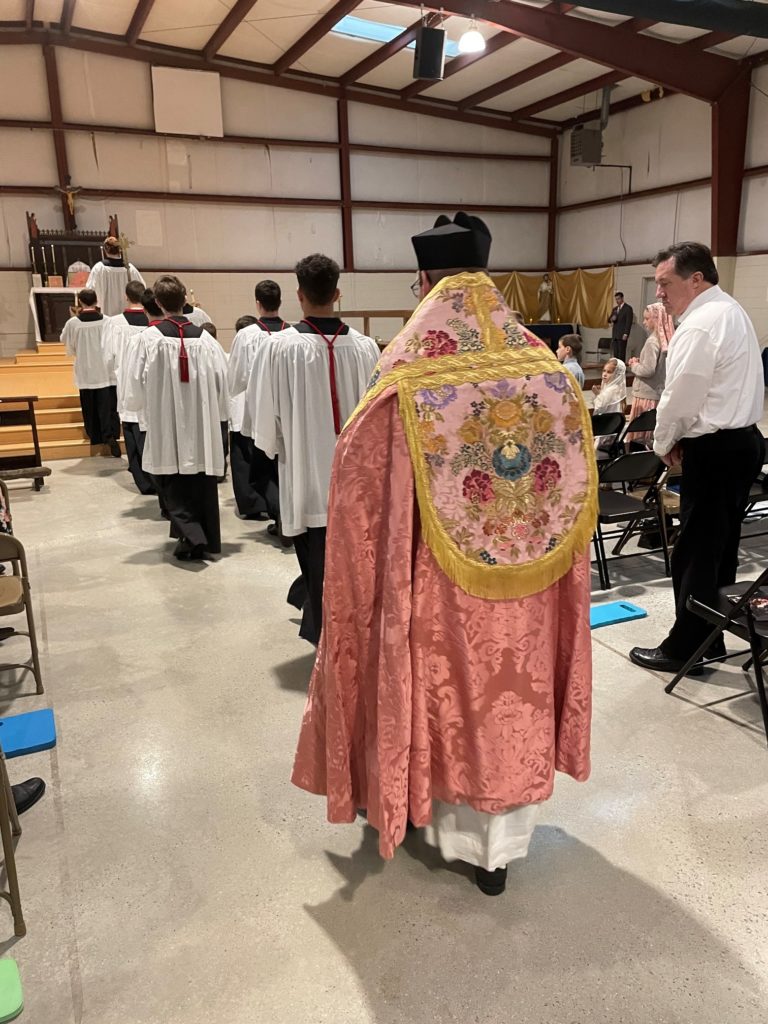

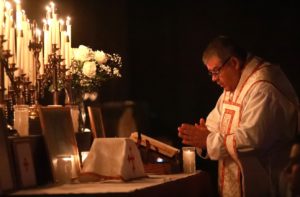
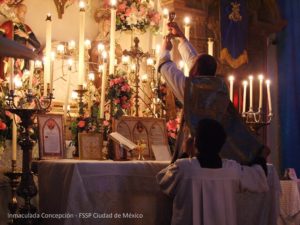

December 21, 2022

Visual Logic: A New Book by Fr. John Rickert
Fr. John P. Rickert, FSSP published a new book in August called Visual Logic: Seeing Classical and Modern Logic, An Introduction. He graciously agreed to answer a few questions on the book and address topics that may be of interest to our readers. –ed.
Q: Why is logic an important subject for Catholics, even those of us who don’t have a career in philosophy or mathematics?
A: Logic, at least to some extent, is necessary for meaningful communication. We have to understand correctly what is being asserted and what is not being asserted, and we have to see whether truths are connected, and if so, how.
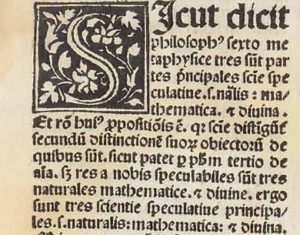 Q: In the book you decry the separation of classical and modern logic. Our FSSP readers probably need no convincing of the former’s value! So what, in your view, have modern theorists brought to the table that has advanced the subject?
Q: In the book you decry the separation of classical and modern logic. Our FSSP readers probably need no convincing of the former’s value! So what, in your view, have modern theorists brought to the table that has advanced the subject?
A: The most important contribution of Modern Logic, in my opinion, was the discovery that logic itself has limits; logic proves that there are true statements that cannot be proved. As the saying goes, “Truth is greater than proof.” In my view, this truth is so important that every educated adult should be aware of it. Modern Logic has also developed in various directions, such as Modal Logic, that the ancients had only glimpses of.
Q: You mention how Kurt Gödel showed the limitations of arithmetic in the 1930s, in contrast with David Hilbert who didn’t seem to admit any such limitation. Is there a wider lesson here about human knowledge that you are pointing to?
A: Yes. The fact that science relies so heavily on mathematics will mean that, at least in theory, there are questions that science will never be able to answer. “Theories of Everything” are an exaggeration, considering that only about 4% of matter is understood and 96% remains a mystery. But even aside from these percentages, there is the more fundamental point that science doesn’t have all the answers. Indeed, science doesn’t even have all the questions.
Q: Logic seems like a very abstract thing to study. But you point out that real-world electronics and computers depend on it. How?
 A: Computers, cell phones, and practically anything programmable such as microwaves use “logic gates” that implement logical ideas such as “and,” “or,” “not,” and “if.” The logical framework they use is due to George Boole and is also a great triumph of Modern Logic. In a way it is remarkable that people can use these inventions without having to know the underlying logic, but it is intellectually rewarding to have some idea of what is going on deep down.
A: Computers, cell phones, and practically anything programmable such as microwaves use “logic gates” that implement logical ideas such as “and,” “or,” “not,” and “if.” The logical framework they use is due to George Boole and is also a great triumph of Modern Logic. In a way it is remarkable that people can use these inventions without having to know the underlying logic, but it is intellectually rewarding to have some idea of what is going on deep down.
Q: You spend several pages on the meaning of the word “if”, and it ends up in a pretty weird place!
A: It does! I think this is an example of why I say that logic straddles both mathematics and philosophy; it does not fit exclusively into either one of these. Ultimately, for logicians, “if” becomes a technical term, like the terms “and,” “or,” and “not,” and then one proceeds on the basis of the definition. Still, this convention does leave a significant gap between what a mathematician or logician means by the word and what all of us in everyday life mean by it, and there are some weird results.
Q: How do visual representations, like the I-graph system or Venn diagrams, help us understand logic?
A: It is a commonplace among mathematicians that most people are either more “computational” (algebraic) or “geometric” (visual) in how they like to understand things. Of course, some are highly gifted at both ways of understanding something. Modern Logic is very heavily algebraic in its approach. There are good reasons for this: For one thing, one can check a proof as mechanically as one can check a calculation. Still, the intuitive side of logic can easily be lost in this approach.
A long time ago, when I studied logic for the first time, I read a very classical treatment that used the system of moods and figures. I am not sure whether I really “got” it, to be honest, but the thought lingered with me for a long time that there must be a clean, simple, easy way to see logic so that it is obvious, and not just the application of memorized rules.
All of sudden, in 2018, it hit me how to represent statements visually, and that combining the diagrams would visualize a syllogism. I have not seen this treatment elsewhere, so a major reason why I wrote the book was to present this approach. I must give my guardian angel a lot of credit. In fact, some very helpful insights came to me even in the course of writing the book.
Q: Who do you think would benefit most from this book?
A: My hope is, if this is not too ambitious, those who are perhaps curious about logic but find it too off-putting, or those who have felt somewhat frustrated by what they have seen of it before. I would be delighted if others experience the sort of “Eureka!” that I did.
Visual Logic: Seeing Classical and Modern Logic is available at Amazon.com.
December 2, 2022

A Priest Forever: Giving Tuesday 2022
It’s Giving Tuesday, and the FSSP priests need your help. We’ve launched the Priest Forever Fund to provide for the physical needs of FSSP priests even when they aren’t able to be active in parish life. But it won’t succeed without you.
Our goal is to raise $200,000 today. Thanks to our generous friends who have given in advance, we’ve already raised $36,507. That leaves us with $163,493 to raise in the next 24 hours.
With your help, we’ll be able to take care of our priests for life!![]()
November 29, 2022

Tolkien’s Creation of Species

As Amazon has released and wrapped up their first season of “The Lord of the Rings: The Rings of Power”, regardless of how the show has performed, it is safe to say that the imaginative world of J.R.R. Tolkien is back on the menu. For many, it is an opportunity to delve back in to a world of fantasy that formed many of our imaginations in our youth; for others, perhaps it is a first taste and an invitation to truly explore this world in its source material for the first time. While the world created by Tolkien is a fantasy, it is a fantasy that comes from the mind and imagination of a Catholic man, and in this way there are many aspects that are imbued with a elements of Catholic faith and symbolism. To this end we offer the following reflection on some of the Catholic symbolism and imagery contained in the world of Tolkien, originally presented by our French district in their publication “Claves”.
Originally published at Claves.org. Translated by Anastasiia Cherygova.
Who are the creatures inhabiting the world of “The Rings of Power”?
The series produced by Amazon opens with a very quick indication of the creation of the world of rings, elves, dwarves and many others – in Tolkien’s writings, these species tell us much about ourselves by means of a symbolic device of a fairy tale, which is possible to decode through the author’s own correspondence.
Introduction: Biblical Allegory or Christian Fairy Tale?
 The Silmarillion and The Lord of the Rings are fairy-tale-like works whose inspiration is inherently Christian. Tolkien formally stated that: “The Lord of the Rings is, of course, a fundamentally religious and Catholic work”.1 However, one must understand in what way it is such: Tolkien never intended to create an allegory of revealed mysteries, like, for instance, was done in the Chronicles of Narnia of his friend C.S. Lewis.2
The Silmarillion and The Lord of the Rings are fairy-tale-like works whose inspiration is inherently Christian. Tolkien formally stated that: “The Lord of the Rings is, of course, a fundamentally religious and Catholic work”.1 However, one must understand in what way it is such: Tolkien never intended to create an allegory of revealed mysteries, like, for instance, was done in the Chronicles of Narnia of his friend C.S. Lewis.2
According to Tolkien, in allegories, the author would use a sort of “code language” which one would then decipher.3 Once the audience discovers how, all the symbols become transparent; for instance, that of Aslan being Christ, the White Witch being the devil, etc.
Tolkien did not write that way: he does not seek to impose on his audience a single framework for decoding. He is also not the master of his work to the point of telling what aspect of the “secondary world” corresponds verbatim, word for word, to another aspect of the “primary world”. Instead, he presents which figures of his fairy tale can be compared to a certain reality because the aforementioned figures are more or less consciously inspired from these realities.4 Thereby we get what we could call a diffused Christian symbolism, spread throughout Tolkien’s entire written corpus, so that every reader may, if desired, put oneself to the task and recognize it. On the surface, The Lord of the Rings does not advertise itself as a Christian work. Yet in its essence and central inspiration it is such a work. From time to time, perhaps even often, in one or another character or situation, a Christian idea would present itself, becoming almost evident, but the reader must be willing to see it.
1. A Christian-Inspired Mythology: Eru, Valar and Maia
Tolkien’s fantasy work begins in The Silmarillion with what could be called a creation myth of his world. Yet from the first lines it is obvious that this creation myth is born of a Christian inspiration. First and foremost because there is only one god. Tolkien’s secondary world is not explicitly Christian – there is no question about the Trinity – but it is basically monotheistic. Everything that exists proceeds from the only god named Eru (the Only One) or Illuvatar (the Illuminator). The first creation, in turn, consists of pure spirits called Ainur (meaning Blessed or Saints) or Valar (meaning Powers or Authorities). Whom do Ainur/Valar resemble in the primary world? With whom are they “associated”? Tolkien responds to this in numerous letters: with angels.5 These are created spirits among whom exists a hierarchy. Some rest with the Only One to sing the eternal music of creation. They are like the seraphim (“angels in waiting”) in the terminology of Dionysius Areopagite. Others are closer to the visible world, Earth, Arda in The Silmarillion, which would become “Middle Earth” after a great cataclysm, reminding us of the Biblical flood and especially the Atlantis myth. These are like the archangels (“sent angels”), working on a mission in the visible world for the sake of its inhabitants. Valar are themselves Ainur, the angelic spirits of the first order that the Only One sent on Earth, and these Valar in turn sent the spirits of a lesser order, Maia. Gandalf is one of the Maia, the most loyal and the most active, sent by Valar in the third age of the world to help humans in their battle against Sauron, who is himself a fallen Maia.
Thus, there is an entire invisible host of creation in Tolkien’s secondary world, a hierarchy of spirits created by the Only One that clearly harkens back to the angelic orders of the Christian revelation. Gandalf was compared by Tolkien to a guardian angel, akin to the guardian angel of Middle Earth.6 And through a character like Gandalf, Tolkien reminds us that the lot of humans in visible creation does not depend only on the visible causes. Instead, humans depend, first and foremost, on the actions of invisible, but completely, real forces. Forces that could sometimes become visible, and that are always helping us or harming us. Man thus belongs to two worlds: to the invisible world through his soul and to the visible world through his body. His battle is therefore primarily a spiritual one, bearing a challenge that surpasses the visible world.
2. Man and His Images: Elves, Dwarves and Hobbits
One of Tolkien’s ideas consists in the fact that, before the “fourth age”, the age of human dominion, many species would appear on Earth and prepare it for the reign of man. These are Elves, the firstborns of the Only One in Arda, as well as Dwarves and Hobbits, or halflings. Why go with these imaginary species, at times similar to man, yet also different from him? Tolkien himself answers quite clearly: elves, dwarves and hobbits are in and of themselves images of man and his nature, with his very complex and very different capacities and aspirations.
Elves
Elves, as writes Tolkien, “represent the artistic, aesthetic and purely scientific aspects of human nature elevated to a higher degree than what we find among humans”. This is why elves are passionate about art, poetry, music, but also sciences. They very much like to work with matter to improve and beautify it. In addition to this, elves possess certain privileges that allow them to attain in their work great perfection. Privileges that are inaccessible for fallen man, specifically immortality. Tolkien specifies that this immortality is limited, measured by the life of the physical world itself. Elves last as long as the Earth itself lasts, until the end appointed by Eru. What will come of them afterwards is not indicated.
Does this suggest that elves are akin to humans raised to perfection in every way, freed from all human foibles? The answer is no: elves could be killed. Even more significantly, they are morally fallible, like all creatures. They could become prideful, egotistical, excessively possessive, as represented in the storyline of The Silmarillion. Elves could become entangled in attachment to their craft to the point of rejecting one of the most essential characteristics of the world: its finitude, its corruptibility, its proneness to change and, ultimately, to destruction. This is the tragedy of the elves: they are immortal, but the created world, which they love deeply, isn’t. If they revolt against this condition, they subsequently become the “embalmers”, those who in vain attempt to rid the present world from its eventual change and from its finitude, constraining it in a “perfect” state, at least in the elves’ eyes.7 They thereby fall victim to the temptation of a kind of transhumanism.
Thus, elves constitute for us, just as Tolkien’s other imaginary species, at one and the same time an example and a warning. If you could surpass yourself by science or by art, if you could create a truly beautiful masterpiece, or if you could discover through your research new scientific realities, you will overcome death as long as it is allotted to you, being “sagely elf-like”. But if you would flee into the aesthetic dreams, if you would become egoistical and possessive about your knowledge or your art, if you would enclose yourself in the nostalgia for a bygone past, then you would become “foolishly elf-like”, degrading yourself by what is supposed to elevate you.
Dwarves
When it comes to the dwarves, they represent an “earthly” side of human nature; the desire to work the land, to extract its various riches, to construct sturdy homes that would defy time. That’s why dwarves are small – close to the ground – robust, capable stone masons, blacksmiths and exceptional goldsmiths, living in mountains and caves. They are brave and tough, but they could also be terribly stubborn, spiteful and prone to unbridled greed, the traits that are exemplified by dragons. This was the situation of Thorin in The Hobbit. The dwarves of Tolkien tell us: “Work the land, shape gold and silver, but do not become voracious like the dragons because you are made for something greater than this.”
Hobbits
Finally, hobbits are an ordinary humble people of simple tastes, with a penchant for good food and cozy homes. They are “average men”, whence comes their small size. They are often too limited, too down-to-earth homebodies, but they are also capable of rising to heroism, if they are helped by their greaters. It is the meeting with Gandalf and the elves that would reveal the dormant heroism of Bilbo and subsequently that of Frodo and Sam.
Conclusion
Through his imaginary species, Tolkien managed to present a lively and convincing image of the possibilities of human nature, of all its strengths and its desires, which could ennoble man or at the same time degrade him. The perfect man would be the one who is able to embody simultaneously the contemplative spirit of the elves, the readiness to work and the patience of dwarves, and the good sense of realism of hobbits. In creating a fellowship of two humans, four hobbits, an elf and a dwarf together around Gandalf, “the guardian angel” of Middle Earth, in their battle against Sauron, it is as if Tolkien tells us: do not neglect anything that you have within yourself, cultivate your best gifts and let the grace of God purify them and elevate them. This is how you will contribute, for your part, to pushing back against evil and increasing the good in the world.
References
- J.R.R. Tolkien, Letters, Letter No. 142 to Fr. Robert Murray, (S.J.), p. 332.
- Tolkien would reiterate this affirmation more than once in his correspondence. For example, in letter 181 to Michael Straight, dated approximately January or February 1956 (estimated), op.cit., pp. 447-448: “There is absolutely no (underlined within text) moral, political or contemporary “allegory” in this work. It is a “fairy tale”, but written – according to the conviction that I previously expressed in a long essay “About the Fairy Tale”, that it is an appropriate audience – for adults. For I think that fairy tale has its own way of reflecting about the “truth”, different from the one expressed in allegory, in satire or in “realism” – and in a certain way a more powerful one.”
- Tolkien underscores several times in his letters that he himself discovered certain characters and certain events of his story in the process of writing. He was personally quite surprised by it. Cf., for instance, letter 163 to W.H. Auden, pp. 416-417.
- We find a good example of this viewpoint in the already cited letter to R. Murray. Father Murray had written to Tolkien that the elf-queen Galadriel made him think of the Virgin Mary. Tolkien answers him by saying: “I think I see exactly what you mean (…) by your references to Our Lady, on whom is built all of my own perception, a limited one, of beauty, in majesty and in simplicity alike” (Letter 142, p. 331). Tolkien did not at all conceive Galadriel as an allegory of the Blessed Virgin. But the Blessed Virgin represents for him an ideal of feminine beauty. In imagining a very beautiful elf-queen, that is to say a human woman, but endowed with a fairy-like beauty which surpasses all the possibilities of this world, he could not have not been inspired, even unconsciously, by the idea that he got from the Blessed Virgin Mary. He thus gave to Galadriel the traits that are “associated” to the Blessed Virgin.
- For example, letter 153 to Peter Hastings, op. cit., p. 373: “The immediate authorities are the Valar (the Powers or the Authorities): the “gods”). But they are only created spirits – of an elevated angelic order, we should say, assisted by lesser angels – worthy of reverence, thus, but not of adoration.”
- Cf. Letter 156 to Robert Murray, November 4, 1954, p. 389: “I would venture to say that he (Gandalf) was an ‘angel’ incarnate, strictly speaking about an ἀγγελος: that is to say, with other Istari, mages, ‘those who know’ (Istari is translated as “wizard” because of a link with the words “wise” or “witting”, mind and knowledge, specified by Tolkien, p. 399), an emissary of the Gods of the West, send to the Middle Earth while a formidable crisis provoked by Sauron was looming on the horizon.” Tolkien well specifies in this letter in what sense Gandalf is really “dead” following the battle with the Balrog, and the fact that his return, with a new body, endowed with greater powers, is not thanks to the Valar, but to the Creator.
- Cf. Letter 181, p. 455 : “Like if a man should hate a very long, unending book, fixating himself on the chapter that he likes the most.” Some elves have “fallen into the trap of Sauron” that the art rings taught them because they had an excessive desire for power, in hopes of “stopping the change, keeping everything new and beautiful, forever.”
November 23, 2022

Advent – Preparation not Anticipation
by Fr. William Rock, FSSP

As early as the day after Halloween, Christmas music begins to be heard. Perhaps even earlier, stores will decorate for Christmas with the associated holiday wares displayed. Throughout December, TV channels will play collections of Christmas movies. Then, on the 26th of December, it all comes to screeching halt. Trees are out on the curb, decorations come down, and we return to our regularly scheduled programing. This way of keeping Christmas, and the days leading up to it, is not the way our Catholic forefathers would have kept it. Christmas and its days were celebrated as Christmas, while the days leading up to Christmas, the days of Advent, were kept as days of preparation, not anticipation.1
As Lent is a penitential period of preparation for Feast of the Resurrection of Our Lord, so Advent (from the Latin for “a coming, an approach, arrival”)2 was a penitential period of preparation for the Feast of the Nativity of Our Lord and for receiving the special graces which accompany it. Advent, then, was considered a mini-Lent. While Church Law has not bound the Latin faithful to penance during Advent in some time, the season still carries the marks of being penitential. The Gloria is not sung during Masses of the Season, the penitential violet is worn, the Altar is not decorated with flowers, and the organ is silent. Historically, the Ite, Missa est was replaced by the Benedicamus Domino and the Deacon and Subdeacon would lay aside their vestments of joy for the folded chasuble. It is incongruous, then, for the faithful to begin keeping Christmas at home while the Church is in such a period of preparation. How then, can the faithful keep this season of Advent in a fitting way, not corrupting this time of preparation by following the world but rather in a Catholic spirit?
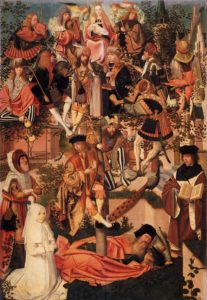
The first way would be to undertake acts of penance. Even if this is not currently enjoined by Church Law, it would be completely in keeping with the liturgical expression of the season. In 1962, the Vigil of Christmas (which is Christmas Eve day, not anticipated Masses said in the evening of the 24th and not the Midnight Mass, which is the First Mass of Christmas) was still kept as a day of fasting and complete abstinence. Additionally, in 1962, Ember Wednesday and Ember Saturday of Advent were days of fasting and partial abstinence (meat only at the main meal) while the Ember Friday was a day of fasting and complete abstinence. It is important to keep in mind that Advent does not only prepare for the liturgical commemoration of the coming of Christ into this world, but also for the coming of Christ into the souls of the believers, and, more, His coming at the end of time as Judge. All three provide ample reason for each to prepare his soul by penitential exercises.
When it comes to decorating, the house should not be adorned for Christmas until slightly before the feast itself. However, Advent Wreaths, Advent Calendars, and Jesse Trees can and should be used as decorations in the weeks leading up to the Nativity. The tree, as it might need to be purchased some time prior to the feast, can be set up and perhaps decorated in a way that befits this season of preparation, perhaps with violet and rose. The lights could be put on, but not yet turned on. With respect to the Nativity creche, the following schedule could be followed, coordinating with the Church’s liturgy:
-
- First Sunday of Advent – Set up the creche (stable-cave) with animals
- Ember Wednesday – Add the figure of Mary as this is the first time she is presented in a Gospel of the Season
- Christmas Eve Day/Vigil of Christmas – Add the figure of Joseph as the Gospel of the Vigil Mass is about his dream-vision
- Following the Christmas Midnight Mass – Add the figures of the Angel and of the Christ Child, as His temporal birth is recounted in the Gospel
- Following the Dawn Mass of Christmas (the Shepherds’ Mass) – Add the figures of the shepherds as the Gospel of the Mass recounts their going to the stable
- Epiphany – Add the figures of the Magi
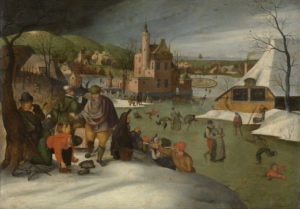
When it comes to music, Christmas carols are best omitted until the feast itself. Advent songs are, of course, highly recommended. The Fraternity of St. Peter, the Benedictines of Gower, and the Monks of Clear Creek all have Advent albums. Songs concerning winter can also be sung keeping in mind that Winter starts astronomically at the winter solstice and the Advent Ember Days liturgically mark the transition from Autumn to Winter. Note too that historically at the liturgy of the First Sunday of Advent, clerics would transition from the Autumn to the Winter volume of the Breviary. Wintery decorations would not be out of place either.
Several feasts punctuate the Season of Advent, such as the Feasts of St. Barbara (December 4th), St. Nicholas (the 6th), St. Lucy (the 13th). Each have their particular home-traditions which the faithful would do well to observe.
Special attention should be given to the Magnificat antiphons sung at Vespers from 17th to 23rd of December inclusively, the Greater Ferias of Advent. These antiphons are known as the “Great Antiphons” or the “O Antiphons” (as they all start with “O”). Unlike throughout the year, these Magnificat antiphons are sung standing. Each antiphon invokes the Messias under a different title: Sapientia (Wisdom), Adonaï (Lord), Radix Jesse (Root of Jesse), Clavis David (Key of David), Oriens (Orient / Day-spring), Rex Gentium (King of the Nations / King of the Gentiles), and lastly Emmanuel (Emmanuel / God is with us). The first letter of each of these titles can be read as a backwards acrostic which spells, in Latin, “Ero cras,” meaning “Tomorrow I will be [there].” These Antiphons are the basis of the hymn “O Come, O Come Emmanuel.”

Having kept Advent in such manner, the faithful will be much better prepared to celebrate Christmas and receive the special graces of the season than had the practices of the world been followed. When the time comes, Christmas should be kept as Christmas, with the decorations, carols, food, and all of the trimmings! This celebration should be extended at least until the Feast of the Epiphany (the 13th Day of Christmas), or the Commemoration of the Baptism of the Lord (the Octave Day of the Epiphany), or even to the 40th and Last Day of Christmas, Candlemas.
William Rock, FSSP was ordained in the fall of 2019 and is currently assigned to Regina Caeli Parish in Houston, TX.
- Much of the historical and liturgical information contained within this article comes from Guéranger, Prosper. The Liturgical Year, 1 (Advent). Trans. Shepherd, Laurence. (Fitzwilliam: Loreto Publications, 2000), chapters 1-3.
- Lewis and Short, s.v. “Adventus.”
November 21, 2022

Minor Orders: November 19, 2022
This Saturday, November 19th, 22 candidates will receive the minor orders of Porter, Lector, Exorcist, and Acolyte, which will be conferred by his Excellency Bishop Robert Finn. The ceremony will take place in the Chapel of Sts. Peter and Paul of Our Lady of Guadalupe Seminary. Both the ceremony and the reception will not be open to the public.
Pray for our Seminarians
November 18, 2022

Join us on Nov. 29 for Giving Tuesday
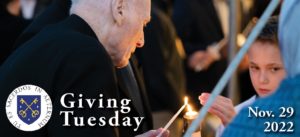 The FSSP is celebrating its thirty-fourth anniversary this year. It will not be long before we see a good group of our members entering a stage of life where active ministry can become limited. We have also had some men, already priests for a number of years, join our ranks. Most Americans retire in their mid-60’s, but one of our priests recently and reluctantly transitioned from actively leading one of our apostolates at the age of 89! All of these priests deserve to know that we will take care of their housing, medical care, and other necessities of life. Many of our priests ordained in the past decades are soon reaching a stage in life in which medical costs can increase exponentially.
The FSSP is celebrating its thirty-fourth anniversary this year. It will not be long before we see a good group of our members entering a stage of life where active ministry can become limited. We have also had some men, already priests for a number of years, join our ranks. Most Americans retire in their mid-60’s, but one of our priests recently and reluctantly transitioned from actively leading one of our apostolates at the age of 89! All of these priests deserve to know that we will take care of their housing, medical care, and other necessities of life. Many of our priests ordained in the past decades are soon reaching a stage in life in which medical costs can increase exponentially.
Some priests will experience serious medical problems. For reasons only He can understand, God sometimes allows His faithful workers to undergo medical hardships that require costly care. In just this last year one of our priests had a sudden illness that required immediate heart surgery. Now he must travel regularly to a specialist doctor for ongoing care. Thanks to God’s providence in giving us many wonderful benefactors who helped us establish the Priest Forever fund last year, we are able to care for our priests without question in such necessities. Father is doing well and continues caring for souls thanks to your support!
Please Support the FSSP’s “Priest Forever” Fund on Giving Tuesday
As the North American Province expands, we will need more priests to work outside of parish life for the benefit of the internal life and working of the Fraternity. There are certain decisions within a community that can only be made by priests. Ordaining more priests, opening more apostolates, and expanding current apostolates will require more oversight and support from provincial headquarters.
As our order grows and ages, the need grows with it. Your ongoing support of this fund helps us provide for the physical needs of our FSSP priests even when they are not assigned to active life in a parish apostolate. Your donation to this fund is a profound “thank you” to our hardworking priests for making a total gift of their lives
Last year, we raised $278,633 to establish this fund. This year, to continue supporting the needs of our priests, we hope to raise $200,000. Here is how you can help.
Please Make Your Gift on November 29th
As you may already know, Giving Tuesday is an annual online event in which nonprofits of all kinds seek to raise money on the Tuesday following Thanksgiving. This year it will be on November 29, 2022.
Your gifts on Giving Tuesday will support the overall good of FSSP priests wherever they find themselves in life, be it working in an active apostolate, assigned to other duties, or in need of medical care. You’ll help us establish new apostolates and staff them with hardworking priests. Your gift will give those priests confidence that just as they have always been there for your spiritual needs, you will always be there to care for their physical needs.
Just in time for winter, donors who give a gift at the $1500 level will receive a Fraternity branded fleece jacket, and those who give a gift at the $500 level will receive an FSSP-branded beanie hat. Additionally, those who give at the $250 level will receive an FSSP holy water bottle. As a special thanks to all who support us, every donor to this fund will be entered into a drawing to win special gifts like rosaries, prayer books, or FSSP-branded items.
Check your email, social media accounts, and the Missive for reminders as Giving Tuesday approaches.
We are always profoundly humbled by your generosity and immensely grateful for your friendship and support. With your help, the FSSP will continue to form priests for life.
November 14, 2022

Building on Rock: Camp St. Peter
In 1998, Camp St. Peter in the Black Hills was born. Since then, the seminarians of OLGS have organized and run successful annual camps for more than 1,000 young boys. In 2020, a not-for-profit organization, Saint John Bosco Camps (SJBC), was founded to continue the camps. The mission of SJBC? To form young men in the virtues they need to become strong Catholics and strong fathers – either as natural fathers of children or as spiritual fathers in the holy priesthood.
SJBC strives to provide the boys of our traditional Catholic communities with a positive experience of the Church and its sacred teachings and traditions through joy-filled interactions with FSSP priests and the seminarians of OLGS. They experience the grandeur of God’s creation during their time in His beautiful, untouched wilderness.
Demand continues to grow for these unique camps. In 2022, SJBC had over 200 applicants, for only 96 spots between its two camps. Up until now the difficulties of renting properties and moving equipment has presented an obstacle to more growth. But SJBC is up for the challenge of meeting this growing demand and is even considering expanding its operations through the offering of additional types of camps in the future. A critical first step is to locate a permanent home for the camps.
In order to secure the foundation of its charism, St. John Bosco Camps has launched a capital campaign, “Building on Rock”, to purchase and develop a property. This campaign will also help establish a fund to develop further programs in the future. Please consider helping St. John Bosco Camps to achieve this goal by donating now at https://www.stjohnboscocamps.org/building-on-rock/.
November 8, 2022


